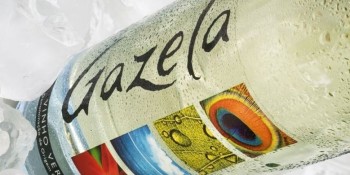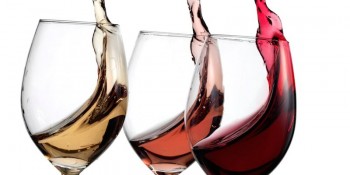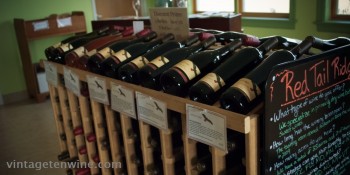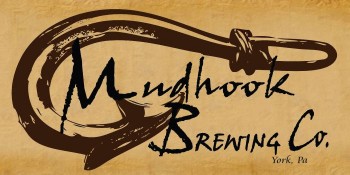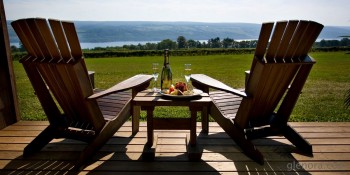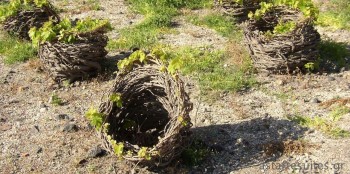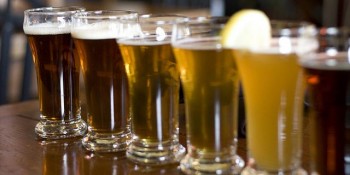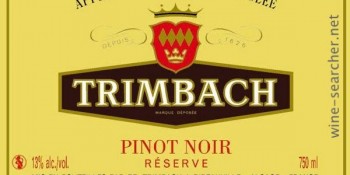When this column began back in January, I wrote about New York wine, focused on the Finger Lakes. This past weekend, I got a chance to visit the area, including tastings at nearly 20 wineries. It was a perfect weekend to visit, with pleasant weather and surprisingly few crowds. My wife and I took a winding journey around Keuka Lake and Seneca Lake, not having time to stop at every winery, and no time at all to visit Cayuga Lake. We found some tremendous wines. It seems like each winery has something unique about it: an interesting story about how the winery got started or how the owners ended up in New York, growing uncommon grapes or making wine using uncommon methods.
In case you’re unfamiliar with the area, the lakes are long and narrow, running north-south through the expanse of New York state ringed by Rochester, Syracuse, Binghamton, and Elmira. Seneca Lake, just barely the second-longest after Cayuga, is 38 miles end-to-end. There are no bridges over the lakes, so if you need to drive to the opposite shore, it’s a bit of a ride.
Interstate 90 provides access to the Finger Lakes from points north (such as Ontario and Quebec), east (New England and upstate New York), and west or southwest (Buffalo, Pittsburgh, and beyond). Visitors from southeast (New York City, Philadelphia) can travel Interstate 81 to Binghamton and branch out from there.
For everyone directly south of the Finger Lakes, which includes my wife and me near Harrisburg, Pennsylvania, as well as travelers from Baltimore and Washington, D.C., take Interstate 83 to U.S. Route 15 through Corning, New York, home to the famed Corning Museum of Glass. From there, take Interstate 86 west, through Bath and Hammondsport (named America’s Coolest Small Town in 2012) to get to Keuka Lake. Otherwise, follow I-86 east to Horseheads, and then choose U.S. 14 to Watkins Glen to access Seneca Lake or U.S. 13 to Ithaca for Cayuga Lake.
Cayuga wineries are along New York Route 89 on the west shore and Route 90 on the east. Route 14 is along the west of Seneca Lake, with Route 414 on the east shore. Keuka Lake lies on Route 54.
The first half of our trip took us on a familiar path, visiting wineries on Keuka Lake and a few on the west side of Seneca Lake. We’ve taken this route a few times before, but manage to find new wineries and new wines each time we visit. The second half of our trip, which I will discuss next time, took us to the east side of Seneca Lake.
There are far fewer wineries on Keuka than on Seneca, and they are mostly clustered along the southern half of the lake. Our first stop was Bully Hill, a long-time Finger Lakes institution on the west side of Keuka. The winery sits high up on a hill with amazing views of the lake below. Bully Hill grew out of a dispute between Walter S. Taylor and the Taylor Wine Company, founded by Walter’s grandfather. Today, Bully Hill is known as the “anti-stuffy” winery on Keuka Lake.
Visitors to Bully Hill can taste of five pre-selected wines (some dry, some sugary sweet), normally with a big crowd of people and the rowdy, entertaining staff, or they can opt for a custom tasting of any wine for $1 each. Since we had done the group tasting multiple times before and almost always focus on dry wines, we opted for a custom tasting. The Estate Blend, cabernet franc, Meat Market Red, and Fish Market White were standouts, and the prices can’t be beat. Bully Hill makes many different wines, with something for every palate.
Down the hill from Bully is Keuka Lake Vineyards, a winery with a very different personality. The tasting room is small and intimate, and the winery operation is much smaller, with far fewer wines available. The winery offers several excellent single-vineyard rieslings, which gives the taster a chance to sample the different Finger Lakes terroirs. We tasted two cabernet franc vintages (2011 and 2012), as well as a Léon Millot, a French-American hybrid red grape.
Traveling back to Hammondsport and up the eastern side of the lake, our third stop was at Domaine Leseurre. Owners Céline & Sébastien Leseurre just opened the winery in the fall of 2013, and the wines are already some of my favorite from New York. The tasting room is also small and intimate, with lots of natural light and beautiful views. Because the winery is so new, only whites and a rosé are available — the reds are not yet ready for release (though a pinot noir and cabernet franc are coming soon, I’m told). Even so, it is well worth stopping to taste the magnificent whites.
Sébastien emphasizes Bâtonnage, an Old World winemaking technique that involves stirring up the lees by hand. This allows the wine to take on a smoother, rounder personality, with layers of well-integrated flavors. Multiple rieslings and chardonnays are offered, and the differences among each are fascinating. Oaked versus unoaked chardonnay, dry riesling versus semi-dry riesling versus a rare oaked riesling, a zippy but not-too-harsh Gewürztraminer, and a refreshing dry pinot noir rosé — all are stunning creations.
From one favorite winery to another: our next stop was Ravines, where my wife and I are wine club members. Visiting the tasting room is always a great experience because of the very knowledgeable staff. Like Bully Hill, Ravines also has an interesting back story, involving a winemaker from Denmark, the purchase of a sought-after vineyard and château in France, and corrupt officials squandering the deal. We are better for it, however, as Ravines owner and winemaker Morten Hallgren settled in the Finger Lakes instead.
The quality of the Ravines wine is easily one of the best in all of New York, and the dry riesling is among the best in the country, consistently scoring 90+ points in major wine ratings. The pinot noir is Hallgren’s real passion, which is a true expression of the grape, and the Meritage blend is also very, very well made (and suitable for cellaring).
Up the road from Ravines is McGregor Vineyards, which has attracted something of a cult following in the Finger Lakes. The winery produces a wide variety of wines, but the Eastern European varietals Sereksiya Charni, Saperavi Rkatsiteli, and Sereksiya Rose set the vineyard apart. McGregor owes its cult status to its popular but pricey Black Russian Red, a blend of Sereksiya Charni and Saperavi Rkatsiteli. A visit to the tasting room, decked out in Clan Gregor plaid and all things Scottish, provides a good experience for anyone, from the novice sweet wine drinker to the serious wino. The Highlands Red is a great value for an everyday table wine.
We stopped at The Olney Place for lunch, a fantastic deli with great beer selection and a catchy motto: “Get this deli in your belly!” The grilled sandwiches are delicious and the sticky buns are legendary (get there early for breakfast if you hope to snag a few).
Here, our journey took a turn to the east, and a short drive brought us from Keuka Lake to the western side of Seneca Lake, the largest lake and home to the most wineries. It’s hard to visit Seneca and not stop at Hermann J. Wiemer Vineyard, which, along with Ravines, is perhaps the best-known winery of the Finger Lakes region. The winery’s namesake came to New York from a German winemaking family and was instrumental in turning the Finger Lakes into an area for fine wine varietals, particularly riesling.
The winery website lists eight different Rieslings currently available, from dry to sweet, and several single-vineyard offerings. Even more astounding, all of them have been scored over 90 points. Don’t get too focused on riesling, however; the other white wines, as well as the pinot noir and cabernet franc, are all extremely well-made. The tasting room is fairly small and intimate, and best of all, it is right among the stainless steel tanks of the winemaking operation.
Just north is Shaw Vineyard, another winery serious about serious wine. More than anything, what sets Shaw apart is the tremendous respect the winery has for the aging process. Wine is barrel- and bottle-aged longer at Shaw than maybe any other winery in the Finger Lakes. In fact, we were tasting reds this past weekend from the 2007 and 2008 vintages. (I have a Chardonnay from the 2005 vintage in my cellar, purchased not long ago.) This is almost unheard of in the region, mostly because of the costs involved.
Growing the grapes, crushing them, and fermenting the juice, is a labor- and time-intensive process. A long time goes by before a crop of grapes brings in any revenue, and Shaw grapes take even longer. But owner Steve Shaw insists on the benefits of his system, and they show in the wines. The 2007 Keuka Hill Reserve, a Bordeaux blend, is particularly enticing — and could warrant even five or 10 more years in the cellar.
Monello Winery is relatively new and a smaller operation but is already growing. Even since my last visit in 2013, several new wines have been introduced. You’ll usually find owner Grace Mirchandani pouring in the tasting room, which is easily identified from the road by a large, red “M” sign. Monello, which in Italian means “brat,” produces mostly dry wines, including a delicious dry riesling and a red blend, called Pella Rosa, perfect for red sauce pasta dishes.
Billsboro Winery has been one of my favorites since my first trip to the Finger Lakes 10 years ago. Unlike most wineries, Billsboro’s tasting room is set in the woods, with a rustic, relaxed feel inside. The dry riesling and pinot gris are both praise-worthy, but the sauvignon blanc was the standout wine during this visit. Billsboro also provided the biggest surprise of the weekend: a Finger-Lakes-grown Albariño. Usually found in Spain and Portugal, the wine is very light-bodied and acidic, making it a perfect pairing for shellfish and light appetizers. Billsboro’s version was no different, delicious and refreshing.
Stay tuned for a trip to the southeastern side of Seneca Lake, sometimes referred to as the “Banana Belt” for its extended growing season, in part 2.
